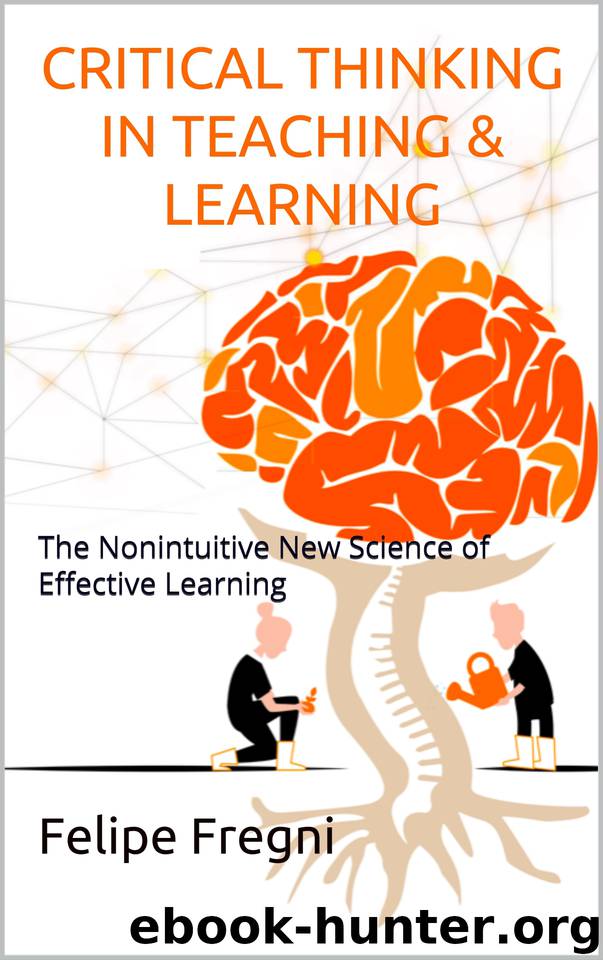Critical Thinking in Teaching & Learning: The Nonintuitive New Science of Effective Learning by Fregni Felipe

Author:Fregni, Felipe [Fregni, Felipe]
Language: eng
Format: epub
Publisher: Lumini LLC
Published: 2019-07-15T16:00:00+00:00
Chapter 6 – Teaching Methods: The Teacher-Centered vs. the Student-Centered Method
First, let us go back to Chapter 4 on motivation. Try to remember the discussion on intrinsic motivation and extrinsic motivation and how they are essential to learning. Now, let us consider the traditional classroom. A professor comes and speaks for about 1 hour (more or less, depending on the format, but usually more than 30 minutes) on content that is predetermined by the instructor. Lectures are generally hardly interactive. Based on what you learned in Chapter 4 on motivation, do these lectures trigger or enhance our learning-related motivation system? Before I respond to this question, another question to you: what is the method of teaching in this example?
This is the typical example of a teacher-centered method. In this method of teaching, information is conveyed mostly in a one-way fashion, meaning that teachers spend most of the classroom time speaking and also give assignments and exams that have a “one-way” format (i.e., questions are asked to students, and it is expected that they answer based on what was told to them). In this method, there are very little opportunities for discussion and interaction, and in fact, students learn mostly on their own.
Going back to the first question (is this method effective? based on what you learned in Chapter 4), let us first analyze intrinsic motivation, to which we ascribed three components: autonomy, mastery, and purpose. It is clear that there is little autonomy for students during the lecture because they must listen to what the teacher has decided to present—not what interests them. However, you might see a potential contradiction, because the teacher has the knowledge and should be the one to determine what is being discussed in classes. Yes, this is true; however, students should also have input with regard to part of the content that is being discussed (as detailed later in this chapter). Thus, a traditional lecture does not provide autonomy to students.
Nevertheless, perhaps students improve their mastery during a traditional lecture. This is unlikely—unless one writes down what he knows about the topic before the lecture and checks whether he was correct as the teacher speaks, which would not be likely to happen. To have mastery, students should be provided with ways of testing their knowledge and analyzing the results.
At the very least, students might be inspired for the meaning of learning to their lives. This is one of the remaining components that teachers can use; however, it might be more relevant for the first 5 or 10 minutes of the lecture. Unless students are reminded of the meaning of that learning to them, they will quickly lose interest.
What about extrinsic motivation? Students are interested in passing the exam; therefore, they pay attention to lectures, because this would provide the content that they need, right? Not really. There is a difference between doing well on exams and learning during a lecture through reflection. A student who is interested in the exam will know that (i) it
Download
This site does not store any files on its server. We only index and link to content provided by other sites. Please contact the content providers to delete copyright contents if any and email us, we'll remove relevant links or contents immediately.
The Art of Thinking Clearly by Rolf Dobelli(10220)
The 5 Love Languages: The Secret to Love That Lasts by Gary Chapman(9588)
Mindhunter: Inside the FBI's Elite Serial Crime Unit by John E. Douglas & Mark Olshaker(9200)
Becoming Supernatural by Dr. Joe Dispenza(8119)
Nudge - Improving Decisions about Health, Wealth, and Happiness by Thaler Sunstein(7615)
The Road Less Traveled by M. Scott Peck(7522)
Enlightenment Now: The Case for Reason, Science, Humanism, and Progress by Steven Pinker(7231)
Mastermind: How to Think Like Sherlock Holmes by Maria Konnikova(7227)
Win Bigly by Scott Adams(7094)
The Way of Zen by Alan W. Watts(6505)
Factfulness: Ten Reasons We're Wrong About the World – and Why Things Are Better Than You Think by Hans Rosling(4694)
The State of Affairs by Esther Perel(4640)
Gerald's Game by Stephen King(4581)
Man's Search for Meaning by Viktor Frankl(4424)
The Confidence Code by Katty Kay(4187)
Thinking in Bets by Annie Duke(4152)
The Healing Self by Deepak Chopra(3474)
Hidden Persuasion: 33 psychological influence techniques in advertising by Marc Andrews & Matthijs van Leeuwen & Rick van Baaren(3472)
The Worm at the Core by Sheldon Solomon(3435)
